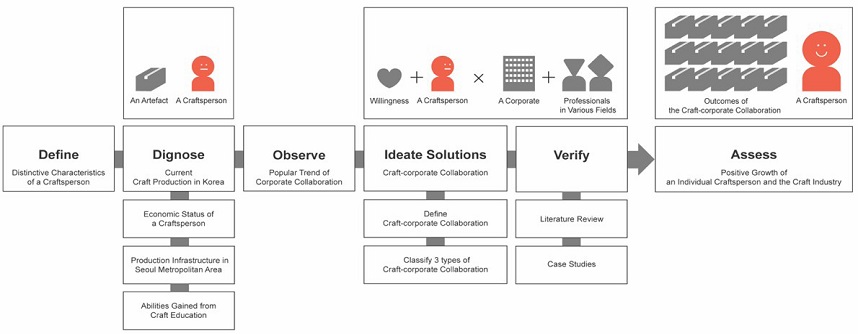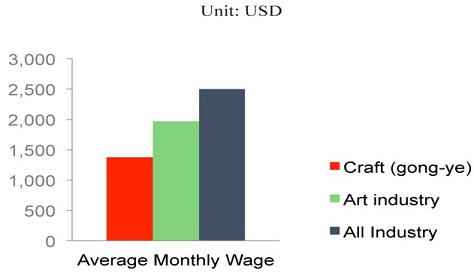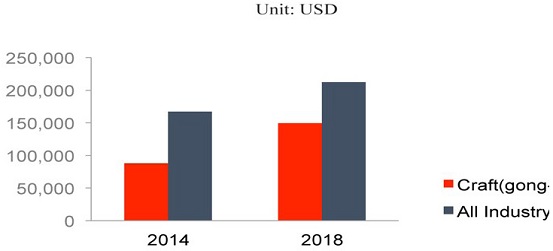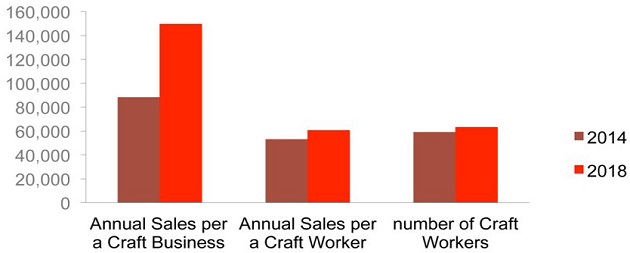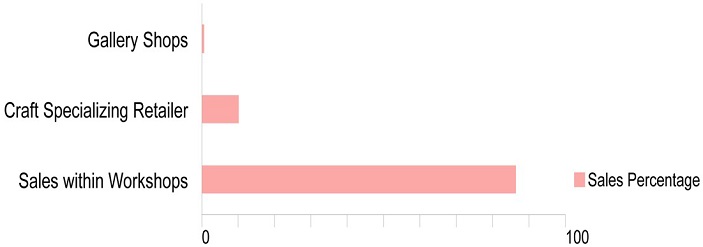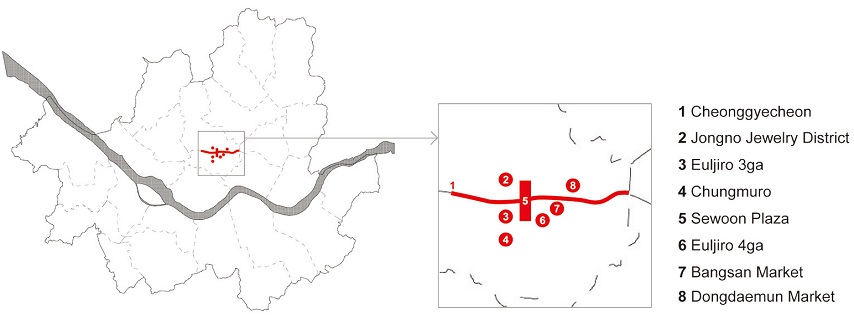
A Study on the Strategic Collaboration System between Craftspeople and Enterprises for Sustainable Development in the Center of Creative Metropolitan City
Abstract
Background South Korean craftspeople face several limitations in performing productive activities. This study aims to define the distinctive characteristics of craftspeople when compared to fine artists and designers to diagnose the current status of craft production in South Korea.
Methods This study uses a comparative method, quantitative data analysis, narrative analysis, and a case study. The number of workers, Seoul’s physical infrastructure, the status of higher craft education, and the trend of corporate collaboration are considered. Craft-corporate collaboration is defined and classified based on craftspeople’s contribution in the collaborative process. This study also identifies a positive ripple effect from individual craftspeople to the country’s socioeconomic condition.
Results Findings suggest that craft-corporate collaboration can apply to foreign countries in the same manner with the expectation of a positive impact.
Conclusions This study analyses the specific conditions for modern craftspeople and the corporates in South Korean society in order for the healthy and innovative craft -corporate collaborations to take place.
Keywords:
Art Collaboration, Crafts, Creative Metropolitan City, Innovation Through Craft, New Product Development1. Introduction
This study is based on Korean crafts, and the words ‘craftsperson’ and ‘crafts’ in the paper respectively refer to craft professionals and crafts in Korea.
Since the time people spend at home has increased significantly due to the COVID-19 pandemic, living design has been attracting attention worldwide. Currently, luxury brands are embracing the trend of rushing to launch new products and showing interest in home decoration and the living sector. While the focus on craft home products is not a new and sudden trend, various companies’ interest in art and crafts has been increasing. Since the pandemic, there has been a clear increase in the consumption of and interest in home products in Korea. Although the effect of COVID-19 here has been relatively small, various events have been cancelled and external activities are repressed to prevent spread of the coronavirus. Thus, interest in home products has accelerated as the time spent at home has increased since February 2020, after the first confirmed case of COVID-19 in Korea.
In line with this trend, companies are gradually appreciating the value and potential of craftsmanship, and increasing cases of industrial link and collaborations with craftspeople (Lee, 2017). This study defines a ‘craftsperson’ as a person with higher education in craft. This includes a person who has graduated from a specialised higher education institute such as university, with a major in crafts-related field, and anyone who performs crafts-based production work.
Conventionally, in cases of corporate collaboration with craftspeople, a craftsperson makes products after a designer has finished designing them. The craftsperson is usually responsible for simply fabricating a prototype, which has already been planned and designed. However, it may be economically reasonable from the company’s perspective if a craftsperson is also involved in the aesthetic choices and specific manufacturing processes, as well as making of the product. Although various approaches to collaborate at many stages of manufacturing processes are currently emerging, the role of craftspeople is still often limited to merely producing commissioned work. However, a progressive approach or a method in which craftspeople lead a project (‘craft-corporate collaboration’) is needed to ensure a creative and innovative outcome of interdisciplinary collaboration.
As described in Figure 1, this study explores ‘craft-corporate collaboration’ as a strategic way for craftspeople to establish sustainable and stable craft production activities by making use of their distinctive characteristics to overcome difficulties in production activities and achieve personal and economic growth as individuals. Moreover, the impact expands to the craft industry and overall economy, as outcomes of the collaboration appear for the broad spectrum of users, making positive changes in various industries.
To discover the solution, two research questions were set:
Research question 1: What is the current status of the craftspeople in Korea, and what is the direction that promotes the development of the Korean domestic craft industry, craft products, and individual craftsperson?
Research question 2: What is a rational means to settle the continuous and stable work production activities of craft professionals in Korea? Can corporate collaboration become way to establish craftspeople’s continuous and stable work production activities?
1. 1. Art, design, and craft: possibility for changes
The concept of creator in the era of the 4th Industrial Revolution is changing rapidly. As the production of prototypes has become easier through digital fabrication, it is a world where anyone can make them with an idea. With the digital tools and open sources widely spread on-line, any individual can start a creative project and become a maker. Inevitably, the making process of an object involves some manual craft activities even when using the digital medium. Thus, this is an era in which anyone can participate in craft activities, which was conducted mostly by professional craftspeople in the past. In addition, industrial trends across the craft industry, such as the integration of crafts and digital technology, the emergence of online platforms specializing in crafts, and the distribution of crafts that share online and offline at the same time, are also changing into contemporary concepts.
There used to be a clear distinction between fine artist, designer, and craftspeople, but now the boundaries are blurring (Sandino & Lees-Maffei, 2004). Risatti (2007) stated that the distinction between craftspeople and designers is often found in prototyping, and that the prototypes of craftspeople are often finished, while designers use prototypes to test products, which do not serve as final products. However, more and more craftspeople are using 3D modelling and 3D printers to distinguish between design stage and manufacturing process (Lee, 2017). These digital fabrication technologies shorten the working hours of craftspeople and possibly increase the quality of products. Unlike in the past, when only hand-made products were recognized as crafts, in the contemporary era, discussions on the new value of crafts are underway as various digital technologies are introduced and expanded through convergence.
1. 2. Formation of Korean crafts and differentiation from Western craft
The formation of Korean crafts is closely related to the history of modern Korea. The term gong-ye roughly translates to craft, craftspersonship, arts and craft of the West. ‘Gong-ye’ and ‘craft’, however, do not have the same meaning due to differences in historical contexts. The meaning of gong-ye was formed based on the history of the modern age of Korea. In this modern age, ‘gong-ye’ has undergone several changes in meaning—from human craft skills, to the manufacturing industry that produced goods for the royal family and exported them abroad, and then to the fine-art related manual industry (Her, 2014). In the contemporary context, although the conception and definition of gong-ye has not yet been established, its perception shares common aspects with specialised techniques, handwork, and practicality. Western craft is often associated with women’s household activities or hobbies and takes a lower position within the hierarchy of art. In Korea, gong-ye has higher status, as historically men inherited the skills and profession over many generations.
1. 3. Current status of Korean crafts
To identify the detailed aspects of the production activities of a craftsperson, it is necessary to review the basic statistical data for the overall status and position of the craft industry in Korea (Korea Craft and Design Foundation [KCDF], 2020a).
In addition, according to recent statistics on the income of craft workers, their average monthly salary was $1,375 as of 2017 (Bae & Korea Labour Institute, 2017). Moreover, the average monthly salary of art industry workers was $1,969, and that of workers in the entire industrial sector was $2,502. This indicates that craft workers’ production activities are meagre, and their income is low (Statistics Korea, 2019).
The annual sales revenue of Korean crafts businesses in 2014 was significantly less than that of each small business, with the result in 2018 still showing large difference despite a sharp increase in sales revenue from $88,229 in 2014 to $149,512 (KCDF, 2020a) compared with the average sales of $212,285 by small businesses (Ministry of SMEs and Startups & Statistics Korea, 2019).
On the other hand, the craft industry’s per capita annual revenue was $53,144 in 2014 and $60,677 in 2018, a 14% rise over four years. In 2014, the industry’s sales revenue was 3,484.4 billion won, with 59,230 total number of workers. However, in 2018, the total annual revenue for the craft industry was 4.2537 trillion won, the number of workers was 63,322, and annual revenue per person was 6.71 million won (KCDF, 2020a). In other words, the number of workers per craft business increased from an average of 1.6 in 2014 to 2.3 in 2018.
This implies that although new craft workers have been continuously entering the industry, the craft industry and related markets have not expanded enough to guarantee adequate sales to both them and the existing workers. In other words, the structure of so-called Red Ocean, in which more competitors are sharing the limited pie of the market, has been entrenched. This not only deepens the competition and increases anxiety and stress for craftspeople, but also results in decreased efficiency and stability of production activities (Kim, 2018).
The distribution channels are also limited to craftspeople. According to the 2015 data, the proportion of craft sales within the workshops increased greatly to 94.3%, while that of specialty craft stores and gallery shops decreased to 11.1% and 0.7%, respectively. Furthermore, online sales (including on online platforms specialising in crafts) and general shopping mall sales have declined since 2011 (KCDF, 2017). Although single-person workshops take the largest proportion of the craft business, the model of craftspeople making, promoting, and selling their own products at the workshop is still dominant (KCDF, 2014).
While there are apparent shortcomings of the craft industry, in 2016, Korea enacted the Craft Culture Industry Promotion Act to gradually address the accumulated problems and shortcomings in the industry. This act is meaningful as the first set of laws related solely to crafts, and it provides a legitimate basis for supporting the crafts sector. However, short-term support for craftspeople is lacking. The majority of government organisations (e.g., Korea Craft & Design Foundation) support the field of crafts through exhibitions and events, but there is not yet legitimate support that provides studio space or production cost to a craftsperson.
Therefore, craft workers experience economic instability compared with workers in other fields, even with the rapid growth of craft businesses in Korea. Small craft workshop owners, which include the majority of craftspeople, continue to experience lack of diversity in distribution channels for production activities. In search for solutions to stabilise craftspeople’s production activities, research must consider the strengths of a craftsperson.
In Korea, about 50.7% of all craft professions are concentrated in the Seoul metropolitan area in Korea (KCDF, 2020b). The biggest reason for this is the locational advantage. A craftsperson can easily find places for necessary materials and processes. Manufacturing infrastructure is especially concentrated in the Seoul metropolitan area, and such a case is very rare worldwide. Seoul has multiple areas of concentration of manufacturing businesses, among which the largest area is at its very centre. For example, one can find works related to clothing and sewing in Dongdaemun and Bangsan Market, acrylic cutting works in Euljiro and Chungmuro, and printing and paper related works in Chungmuro. The manufacturing infrastructure in this area has a characteristic that allows not only large production orders but also orders for multi-product, small-quantity production. Furthermore, despite being located in the centre of Seoul, the existence of many companies leads to lower costs compared with those in cities in Western countries such as the United States and United Kingdom.
Manufacturers’ concentration in the middle of metropolitan areas in Korea has a historical background. After the independence of Korea in 1945, as US troops were stationed for a short time in the Euljiro area, various products were sold in the area, and Korean people gathered here to make living out of selling the products. Within the large infrastructure, areas were subdivided based on products and services with similar materials and processes.
The various workshops have been segmented, specialised, and become concentrated, and people engaging in crafts in Korea can appropriately take advantage and apply their production activities. In fact, some Korean students majoring in crafts interact with these companies and use them for school projects, so one can easily find ‘student’s work’ written on the windows of various manufacturers (e.g., precision processing, metal casting, acrylic processing, and woodworking shops).
A craftsperson needs to experiment with different materials and processes, make study models, continue to improve and polish an idea before finishing a product, and repeat the entire process several times if necessary. The concentrated infrastructure areas allow craftspeople to do so conveniently without spending a major upfront cost. As a result, there are a growing number of craftspeople who produce and sell products based on trends in the rapidly expanding offline and online (mobile and media commerce) markets. A craftsperson can increase work efficiency while significantly reducing time and effort by outsourcing repetitive and mechanical work processes and continuously engaging in ‘small-quantity batch production’.
In the curriculum of the craft-related departments, the convergence education is spreading as the boundaries between academic areas are broken. Craftspeople are educated and trained to ‘work manually on their own’ in all production processes, from product planning and design to work completion. Furthermore, it is now a trend to include digital design education, such as 3D designs and drawings essential for design, in curricula for craft majors, unlike before, when manual work and direct production were focused more. Craftspeople with a certain level of craft production skills and sufficient accumulated direct production experiences can sufficiently display their comprehensive capabilities in corporate collaboration projects as all-around artists.
In sum, the Korean craft industry is experiencing a rapid growth, although it is relatively unstable economically compared with other industries. In addition, the environmental infrastructure required for production is well established in the Seoul metropolitan area, where the majority of craftspeople are located. Hence, instead of undertaking manual production of all processes in-house, some can outsource parts of the process to increase efficiency and productivity while also paying attention to diversifying production activities. Currently, various attempts are made with additional focus on the field of craft around the world, and the craftspeople are well prepared for cross-sectorial collaboration, given their unique educational backgrounds.
Although support from related government departments is increasing and diversifying each year, it is still difficult for craftspeople to obtain direct support for studio workshop spaces or production expenses. Therefore, individual craftspeople are poised to overcome the current situation by taking advantage of the available infrastructure and inherent abilities.
1. 4. Craft-corporate collaboration
The growing interest of corporates in cross-sector collaboration and the field of craft is encouraging because it can provide opportunities for more stable, diverse, and expandable production activities for craftspeople.
Art collaboration began in the fashion industry and gradually spread to other industries. Collaboration subjects have also expanded from art works to the whole spectrum of arts, including pop art, performing arts, foods and beverages, and products and electronics, with diversifying collaboration methods. In recent years, a growing number of global companies have collaborated with the craft sector. The Louis Vuitton Moët Hennessy Group’s Loewe Craft Prize (Loewe Foundation, Spain, fashion) is given to outstanding new craft professionals annually, providing international exhibition opportunities along with prize money. The International Talent Support Competition (Swarovski, Austria, precious metals) and Lexus Design Award (Lexus, Japan, vehicles) are also examples showing the increased interest of companies in the craft sector.
In Korea, companies are increasingly commissioning craftspeople to develop spaces for coffee shops, showrooms for fashion brands, etc. In addition, the interest in living crafts has increased rapidly, with stores specialising in living crafts now present in all major department stores, and large corporations have also started new craft retail platforms. There is a growing trend of boutique shops commissioning craftspeople to produce products found only at their shops.
However, because of the fast pace of these companies’ activities, adverse effects are inevitable. Objects that hold originality are easily copied and repeatedly appear in the market; low-priced and low-quality crafts are often sighted because of the competition structure. As a result, despite the increase in total market revenue, the economic condition of craftspeople is still unstable. Therefore, this overloaded narrow craft market needs to expand, and craft-corporate collaboration may help.
Craft-corporate collaboration aims at future growth while overcoming the current problems of the craft industry. A craftsperson participates in the whole or part of the planning, production, distribution, and sales of products and services through artist collaboration or a freelance contract with a company. It is a strategic production activity method that offers economic stability to a craftsperson at the personal level. Being exposed to a broad spectrum of production processes and accumulating various experiential knowledge, craftspeople can expand the scope of their roles and gain opportunities to interact with experts in various fields.
Type 1: simple collaboration. In this type, a craftsperson is responsible for only the production or design of the commissioned work; commission works are given with designs and instructions created prior to the collaboration. The contribution and responsibility of the craftsperson are relatively low, and their motivation may be low as well.
Type 2: complex collaboration. Here, a craftsperson provides a product prototype in response to the immediate manufacturing demand of the company or provide a product specification for production. The craftsperson’s contribution and responsibility are high.
Type 3: challenging collaboration. In this type, a craftsperson contributes to the development of new products and materials by performing experiments, research, etc., by utilising the key technologies of the company. When a company and a craftsperson collaborate on an equal footing to develop new products or materials, ‘craft innovation’ can occur. The craftsperson’s contribution and responsibility are the highest.
1. 5. Previous research related to craft-corporate collaboration
In an article titled ‘Dangerous Liaisons: Relationships between Design’, craft, and art, the meaning of crafts and the changing relationship between art and design are introduced through the remarks of several scholars amidst the historical and social changes over the past 200 years (Sandino & Lees-Maffei, 2004). In this study, various interpretations of crafts by scholars such as Martina Droth, Melanie Unwin, Mary Watts, Pamela Gerrish Nunn, Jo Turney, and Linda Sandino are introduced through examples and backgrounds of the time periods. However, research on specific relationships between modern craftspeople and the industry and crafts in the Korean society, that this study addresses, has been insufficient or absent since the study focused on describing the conceptual and abstract features of crafts. Thus, we examine in this study, the specific relationships between modern craftspeople and the industry and crafts in the Korean society.
With the goal of revitalising the craft industry, the British Crafts Council and KPMG published a joint report in 2016 titled ‘Innovation through Craft: Opportunities for Growth’ (KMPG, 2016). The report mainly discusses four craft-corporate collaboration attempts made by the Craft Council, including the cases of Bentley (a UK vehicle manufacturer) and textile company developing 3D weaving. Each of these Type-3 craft-corporate collaborations were formed by matching a craft professional and a partner firm. The collaborations aimed to converge crafts with science and technology to develop new materials or technologies, and through this, the report expects economic benefits in the long run. However, the report focuses mainly on the craft’s contribution to the society and national economy; it does not present any research on the economic stability, personal development, and quality of life of an individual craftsperson.
Temeltaş in ‘Collaboration and exchange between “craftsperson” and “designer”: Symbiosis toward product innovation’, shares new product development (NPD) cases in collaboration between designers and craftspeople (Temeltaş, 2017). He explained that craftspeople’s characteristics, such as ‘risk taking’, ‘holistic approach in practice’, and ‘prototyping’, contributed to the innovation process. Temeltaş also divides the innovation process into three stages: knowledge production, knowledge application, and knowledge, and he describes the steps craftspeople utilised within the studied cases. However, these case studies highlight only the role of craftspeople and their strengths in character as tools to adopt in parts of the NPD process. There is no mention of craftspeople as innovative producers and developers who can lead the entire NPD process without designers. It also did not mention the role of companies or the society in supporting and collaborating with craftspeople.
2. Research design
This study uses a comparative method, quantitative data analysis, narrative analysis, and a case study, as discussed in Table 1.
The comparative method is the process of comparing situations, groups, cultures, etc., that are similar and yet differ in known ways (Hantrais, 1995). This study compares craftspeople with designers and fine artists; Korean craft with Western craft; Korean craft business with Korean small business; Korean craft workers with art-related workers, and the workers in all industry.
Quantitative data analysis means analysing data that are numbers-based (as opposed to word-based) or data that can be easily ‘converted’ into numbers without losing meaning (Jansen & Warren, 2020). Therefore, this method was used to explain changes in the scale of the Korean craft industry and economic status of a craftsperson.
Narrative analysis refers to a cluster of analytic methods for interpreting texts or visual data that have a storied form (Figgou & Pavlopoulos, 2015). The historical background of the Korean craft industry’s infrastructure concentrated in the central area of the capital city, Seoul, was described through the narrative analysis method.
Case study is a way of understanding real issues through examples (Leon et al., 2016). Thus, this study adopts the case study method to classify craft-corporate collaboration into three types and explaining each.
3. Findings
The craft-corporate collaboration examined in this study is summarised in Table 2 and Figure 7.
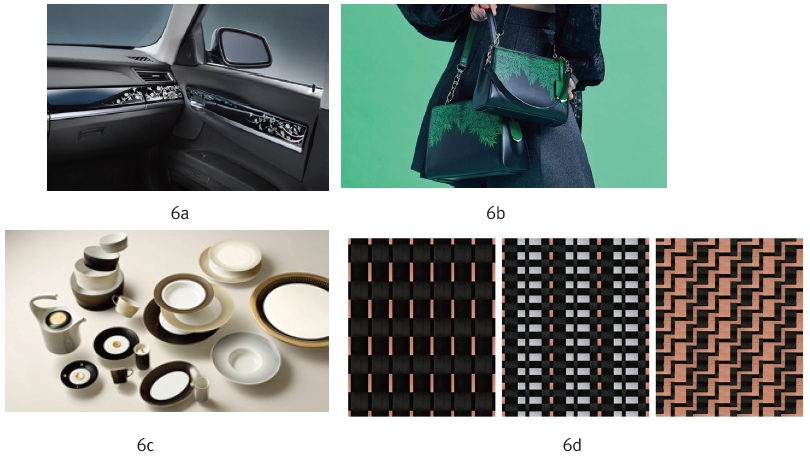
6 Craft-corporate collaboration cases: craft-corporate collaboration outcomes for 6a BMWa ; 6b Louis Quatorzeb from the Korean 2014 Functionality-Associated Craft Product Development Contest; 6c ceramic collection manufactured using originals produced through craft-corporate collaboration with Fürstenberg, a ceramic company; 6 visual mockups for hybrid material pattern designs made for communication with company workers. aAn image of BMW’s craft-corporate collaboration outcome from Maeil Business News. Retrieved 25 March, 2021, from http://naver.me/GY2p9uOzbAn image of Louis Quatorze’s craft-corporate collaboration outcome from KCDF’s blog Retrieved 25 March, 2021, from https://blog.naver.com/kcdf2010/220878580008
As stated in Table 2, there are several expected benefits of craft-corporate collaboration. The first apparent benefit is the gradual overcoming and resolution of the instability of a craftsperson’s production activities. By diversifying and expanding work processes, craftspeople can accumulate a variety of experiential knowledge. They can also provide socio-economic impacts and gain personal growth. Moreover, corporate collaboration is a strategic production activity that aims at future growth while overcoming the current shortcomings of the Korean craft industry. It can provide essential and fundamental solutions by expanding and improving production activities, which are the domestic craft industry’s internal and own capabilities. Furthermore, by providing products and services with highly aesthetic, artistic, and practical values, it improves the artistic quality of life of society members.
The following case studies apply the three types of craft-corporate collaboration methods.
3. 1. Case 1, Type 1: Craft-corporate collaboration of the Korean 2014 Functionality-Associated Craft Product Development Contest
The Ministry of Culture, Sports, and Tourism in Korea launched the 2014 Functionality-Associated Craft Product Development Contest to promote collaboration projects of domestic and foreign luxury companies teaming with renowned artists and artisans for high-end commercialisation of craftworks (Kim, 2018). Examples include the BMW 750Li Korean Art Edition, applying the Najeon Chilgi craft technique (Figure 7a) and bags of Louis Quatorze, a fashion brand, applying the Chae-hwa-chil lacquer technique (Figure 7b). While this case of collaboration was successful in introducing traditional Korean craft techniques and their beauty, the designers developed the product for the most part, and the craftspeople’s role was limited to applying traditional craft techniques to the products’ surface.
3. 2. Case 2, Type 2: Craft-corporate collaboration of a ceramic company commissioning a craftsperson to design a collection and produce the originals
Fürstenberg’s porcelain collection design was created in collaboration with a ceramic craftsperson who made the white porcelain originals of the collection by hand. The originals were then utilised to create plaster moulds for manufacturing the collection (Lee, 2017). A craftsperson served as original maker of the working prototype/product for the collection, and as shown in Figure 7c, the collection continues in different shades and patterns today. This case of collaboration with a craftsperson exemplifies the production of prototype originals and shows the distinction between craftspeople and designers often found in prototyping. The craftspeople’s prototypes are finished products, whereas designers use prototypes to test the products to be made, and these do not serve as end products (Risatti, 2007).
3. 3. Case 3, Types 2 and 3: Researcher’s direct craft-corporate collaboration with a carbon composite manufacturing company
During this collaboration, a new hybrid material using carbon fibre woven together with hair-thin metal wires was developed. Moreover, pattern designs using the material were prototyped in both a physical paper model (Figure 7d) and digital versions to communicate with researchers at the company’s laboratory to pass a series of mass production simulation tests and with workers in the manufacturing sector. Some of the patterns are shown in Figure 7e. The researcher then designed a set of office stations using the designed patterns for the company’s VIP clientele. The following were important considerations during the design stage: (1) the design of the products and processes should enable in-house production for the company’s factory, and (2) the products must use and highlight the designed patterns as marketing tools.
By using accumulated knowledge and experience of manufacturing and design as a craftsperson, the researcher could actively express opinions related to the production and design of the products to the company. The company worked with the researcher to form a team to efficiently carry out collaborative activities. The researcher continuously provided both digital and physical prototype models to deliver the exact design cut for the manufacturing process, which reduced possible errors in the production. Once the ongoing joint meetings with the team stabilised over time, an ideal collaboration structure was created.
4. Discussion
In Korea, we often find cases of craftspeople attempting to expand their craft production activities through craft-corporate collaboration opportunities. However, most public design and corporate collaboration projects still utilise designers to make decisions on their work. In comparison, the role of craftspeople is often limited to the making process according to a given design. Utilising different types of craft-corporate collaboration for the craftspeople to choose from may be a way to overcome the current limitations of craft production and distribution. Furthermore, craftspeople can exhibit and use their versatile abilities through the expansion of their roles.
In addition, to create an equal and sound collaborative structure in ‘craft-corporate collaboration’, efforts and understanding of the companies is required. More importantly, a craftsperson must carry out autonomous activities with intentions in craft-corporate collaboration, rather than passively following the given directions. If a craftsperson strives not to lose the autonomy of craft activities and the intrinsic value of craft, and if this is conveyed properly to the companies, ‘craft-corporate collaboration’ will be fulfilled in a true sense.
5. Conclusion
The current situation of craftspeople in Korea has been discussed, and the concept of ‘craft-corporate collaboration’ is identified as a possible solution for individual craftspeople.
There are three conditions for healthy and innovative craft-corporate collaborations. First, a craftsperson with in-depth understanding and accumulated experience of products, materials, and their processes must be present. The craftsperson must have access to production infrastructure used to obtain various production experiences such as in the Seoul metropolitan area. Second, a company should recognise the craftsperson as a partner with integrative production ability, and not just as a person with skills. When it collaborates solely with a craftsperson (as opposed to hiring both a designer and an artist), the inherent characteristics of a craftsperson will result in an innovative collaborative outcome. An equal collaborative environment is thus ideal for companies and craftspeople. In this case, synergy between the two sides will lead to innovation through craft, a convergence in a true sense, which cannot be achieved by one craftsperson or a company alone. Lastly, craftspeople with active willingness to improve their ability to use diverse and advanced equipment and technology, expand their territory, and collaborate with experts in various fields can grow at a personal level, contribute to society and the national economy at large, and reach innovation through craft.
If these three conditions are met, the craft-corporate collaboration method may be applied to any country. This study contributes to the literature as one of the first studies to examine specific relationships among modern craftspeople, the industry, and the crafts in South Korean society.
Notes
Copyright : This is an Open Access article distributed under the terms of the Creative Commons Attribution Non-Commercial License (http://creativecommons.org/licenses/by-nc/3.0/), which permits unrestricted educational and non-commercial use, provided the original work is properly cited.
References
- Bae, K. S., & Korea Labor Institute [KLI]. (2018). 2017 Employment impact assessment: Employment effects of fostering craft professionals and resolving manpower mismatch in supply and demand (p. 12). Geumnam-myeon: KLI.
- Crawford, M. B. (2010). Shop class as soulcraft: An inquiry into the value of work. London: Penguin Books.
-
Figgou, L., & Pavlopoulos, V. (2015). Social psychology: Research methods. International Encyclopedia of the Social & Behavioral Sciences, 22, 544-552.
[https://doi.org/10.1016/B978-0-08-097086-8.24028-2]

- Hantrais, L. (1995). Comparative research methods. Social research update. Retrieved May 5, 2022, from https://sru.soc.surrey.ac.uk/SRU13.html.
-
Her, B. (2014). The formation of the concept of Gong-ye in the Korean modern age. Journal of Design History, 27(4), 335-350.
[https://doi.org/10.1093/jdh/epu034]

-
Herrera, S., Cisternas, L. A., & Gálvez, E. D. (2015). Simultaneous design of desalination plants and distribution water network. Computer Aided Chemical Engineering, 37, 1193-1198.
[https://doi.org/10.1016/B978-0-444-63577-8.50044-9]

- Jansen, D., & Warren, K. (2020, December). Quantitative data analysis methods & techniques 101. Grad Coach. Retrieved March 29, 2022, from https://gradcoach.com/quantitative-data-analysis-methods/.
-
Kim, S. M. (2018). A study on the development of convergence through the current status of the craft industry. Korea Institute of Exhibition Industry Convergence, 35, 59-68.
[https://doi.org/10.17548/ksaf.2018.09.30.59]

- Kim, Y. H. (2018, April 9). Seoul, the three generations of Cheonggyecheon makers exhibited… "Do you remember Sewoon Sangga at that time?". Financial News. Retrieved February 10, 2022, from https://www.fnnews.com/news/201804090845586215.
- Knowing Neighborhood. (2017, January 31). Printing workshop that inherits the history of Chugmuro printing alley - Design store. Retrieved March 29, 2022, from https://m.post.naver.com/viewer/postView.nhn?volumeNo=6239710&memberNo=7436453.
- Koo, K. H. (2019, May 20). MB Cheonggyecheon and Park Won-Soon's Euljiro redevelopment. What's the difference. KBS News. Retrieved March 10, 2022, from http://news.kbs.co.kr/news/view.do?ncd=4204417&ref=A>.
- Korea Craft & Design Foundation. (2014). White paper on craft 2013 (pp. 127-133). Seoul: KCDF.
- Korea Craft & Design Foundation. (2017). Status and development study of the craft industry 2015. In White Paper on Craft 2014-2015 (p. 122). Seoul: KCDF.
- Korea Craft & Design Foundation. (2020a). Craft report advanced research 2019 (p.3). Seoul: KCDF.
- Korea Craft & Design Foundation. (2020b). 2019 press release on craft industry survey results (for businesses in 2018): The craft industry increases its sales by 19.7% Over 3 years (p.1). Seoul: KCDF.
- KPMG. (2016) Innovation through craft: Opportunities for growth. A report for the crafts council executive summary. London: KPMG.
- Kwon, S. C. (2014, February 10). Dongdaemun fashion story. Aving News. Retrieved February 1, 2022, from http://kr.aving.net/news/view.php?articleId=779049&Branch_ID=kr&rssid=naver&mn_name=news.
-
Lee, J. H. (2017). The industry link as the way to diversify production channels in the field of craft. Journal of the Korean Society of Design Culture, 23(2), 531-545.
[https://doi.org/10.18208/ksdc.2017.23.2.531]

- Lee, S. B. (2019, October 29). Pyeonghwa Market, which sold abandoned US military clothes in the 1960s... "Excellent" as a global fashion town that attracts tourists. Hankyung. Retrieved February 1, 2022, from https://www.hankyung.com/economy/article/2017102943061.
- Lee, Y. S. (2017). 3D printing role in the craft industry and future job. Bulletin of Korean Society of Basic Design & Art, 18(6), 431-443.
-
Lees-Maffei, G., & Sandino, L. (2004). Dangerous liaisons: Relationships between design, craft and art. Journal of Design History, 17(3), 207-219.
[https://doi.org/10.1093/jdh/17.3.207]

- Ministry of SMEs and Startups & Statistics Korea (National Statistical Office). (2019). Interim results of survey on small business as of 2018 (p. 7). Seoul: Ministry of SMEs and Startups & Statistics Korea.
- Risatti, H. (2007). A theory of craft: Function and aesthetic expression (68-90). Chapel Hill: University of North Carolina Press.
- Sennett, R. (2009). The craftsman. New Haven: Yale University Press.
- Seoul Live Guide. (2019, May 9). Selected as the first course of Shineulji tour. Seoul&. Retrieved March 20, 2022, from http://www.seouland.com/arti/culture/culture_general/5080.html.
- Statistics Korea. (2019). 2017 income (compensation) results per wage-work jobs. Daejeon: Statistics Korea.
-
Temeltaş, H. (2017). Collaboration and exchange between "craftsman" and "designer": Symbiosis towards product innovation. The Design Journal, 20(sup1), S3713-S3723.
[https://doi.org/10.1080/14606925.2017.1352876]

